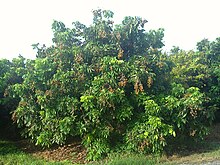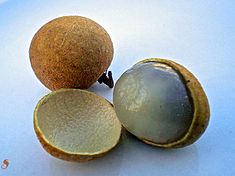Dimocarpus longan
| Longan Dimocarpus longan |
|
|---|---|
 |
|
 |
|
| Longan fruit | |
| Scientific classification | |
| Kingdom: | Plantae |
| (unranked): | Angiosperms |
| (unranked): | Eudicots |
| (unranked): | Rosids |
| Order: | Sapindales |
| Family: | Sapindaceae |
| Genus: | Dimocarpus |
| Species: | D. longan |
| Binomial name | |
|
Dimocarpus longan Lour. |
|
| Synonyms | |
|
|
| Longan | |||||||||||||||||||||||||
| Traditional Chinese | 龍眼 | ||||||||||||||||||||||||
|---|---|---|---|---|---|---|---|---|---|---|---|---|---|---|---|---|---|---|---|---|---|---|---|---|---|
| Simplified Chinese | 龙眼 | ||||||||||||||||||||||||
| Literal meaning | "dragon eye" | ||||||||||||||||||||||||
|
|||||||||||||||||||||||||
| Transcriptions | |
|---|---|
| Standard Mandarin | |
| Hanyu Pinyin | lóngyǎn |
| Wade–Giles | lung2-yen3 |
| IPA | [lʊ̌ŋ.jɛ̀n] |
| Wu | |
| Suzhounese | lón-ngê |
| Yue: Cantonese | |
| Yale Romanization | lùhng-ngáahn |
| Jyutping | lung4-ngaan5 |
| Southern Min | |
| Hokkien POJ | lêng-géng |

A peeled longan fruit
|
|
| Nutritional value per 100 g (3.5 oz) | |
|---|---|
| Energy | 251 kJ (60 kcal) |
|
15.14 g
|
|
| Sugars | n/a |
| Dietary fiber | 1.1 g |
|
0.1 g
|
|
|
1.31 g
|
|
| Threonine | 0.034 g |
| Isoleucine | 0.026 g |
| Leucine | 0.054 g |
| Lysine | 0.046 g |
| Methionine | 0.013 g |
| Phenylalanine | 0.030 g |
| Tyrosine | 0.025 g |
| Valine | 0.058 g |
| Arginine | 0.035 g |
| Histidine | 0.012 g |
| Alanine | 0.157 g |
| Aspartic acid | 0.126 g |
| Glutamic acid | 0.209 g |
| Glycine | 0.042 g |
| Proline | 0.042 g |
| Serine | 0.048 g |
| Vitamins | |
| Thiamine (B1) |
(3%)
0.031 mg |
| Riboflavin (B2) |
(12%)
0.14 mg |
| Niacin (B3) |
(2%)
0.3 mg |
| Vitamin C |
(101%)
84 mg |
| Minerals | |
| Calcium |
(0%)
1 mg |
| Iron |
(1%)
0.13 mg |
| Magnesium |
(3%)
10 mg |
| Manganese |
(2%)
0.052 mg |
| Phosphorus |
(3%)
21 mg |
| Potassium |
(6%)
266 mg |
| Sodium |
(0%)
0 mg |
| Zinc |
(1%)
0.05 mg |
|
Link to USDA Database entry
Vitamin B6/Folate values were unavailable |
|
|
|
| Percentages are roughly approximated using US recommendations for adults. Source: USDA Nutrient Database |
|
Dimocarpus longan, commonly known as the longan (UK: /ˈlɒŋɡən/; US: /ˈlɑːŋɡən/, /ˈlɔːŋɡən/), is a tropical tree that produces edible fruit. It is one of the better-known tropical members of the soapberry family (Sapindaceae), to which the lychee also belongs. Included in the soapberry family are the lychee, rambutan, guarani, koran, pitomba, Spanish lime and ackee. Longan is commonly associated with lychee, which is similar in structure but more aromatic in taste. It is native to Southern Asia.
The longan (from Cantonese lùhng-ngáahn 龍眼, literally "dragon eye"), is so named because it resembles an eyeball when its fruit is shelled (the black seed shows through the translucent flesh like a pupil/iris). The seed is small, round and hard, and of an enamel-like, lacquered black. The fully ripened, freshly harvested fruit has a bark-like shell, thin, and firm, making the fruit easy to peel by squeezing the pulp out as if one is "cracking" a sunflower seed. When the shell has more moisture content and is more tender, the fruit becomes less convenient to shell. The tenderness of the shell varies due to either premature harvest, variety, weather conditions, or transport/storage conditions.
...
Wikipedia

